Introduction
Welcome to the world of garden gate ideas, where your entryway can become a conversation starter and a signature piece of your outdoor space! Imagine stepping into your garden through a beautifully crafted gate that sets the tone for the delightful beauty beyond. It’s like having a friendly welcome mat that says, “Come on in, and let’s enjoy nature together!”
Have you ever noticed how much a simple gate can transform a garden? It’s not just a barrier; it’s a portal to a magical realm of blooming flowers and whispering leaves. Whether you want a rustic wooden gate that exudes charm or a sleek metal design that screams modern elegance, the choices are endless. But with so many options, how do you decide which path to take—or should I say, which gate to choose?
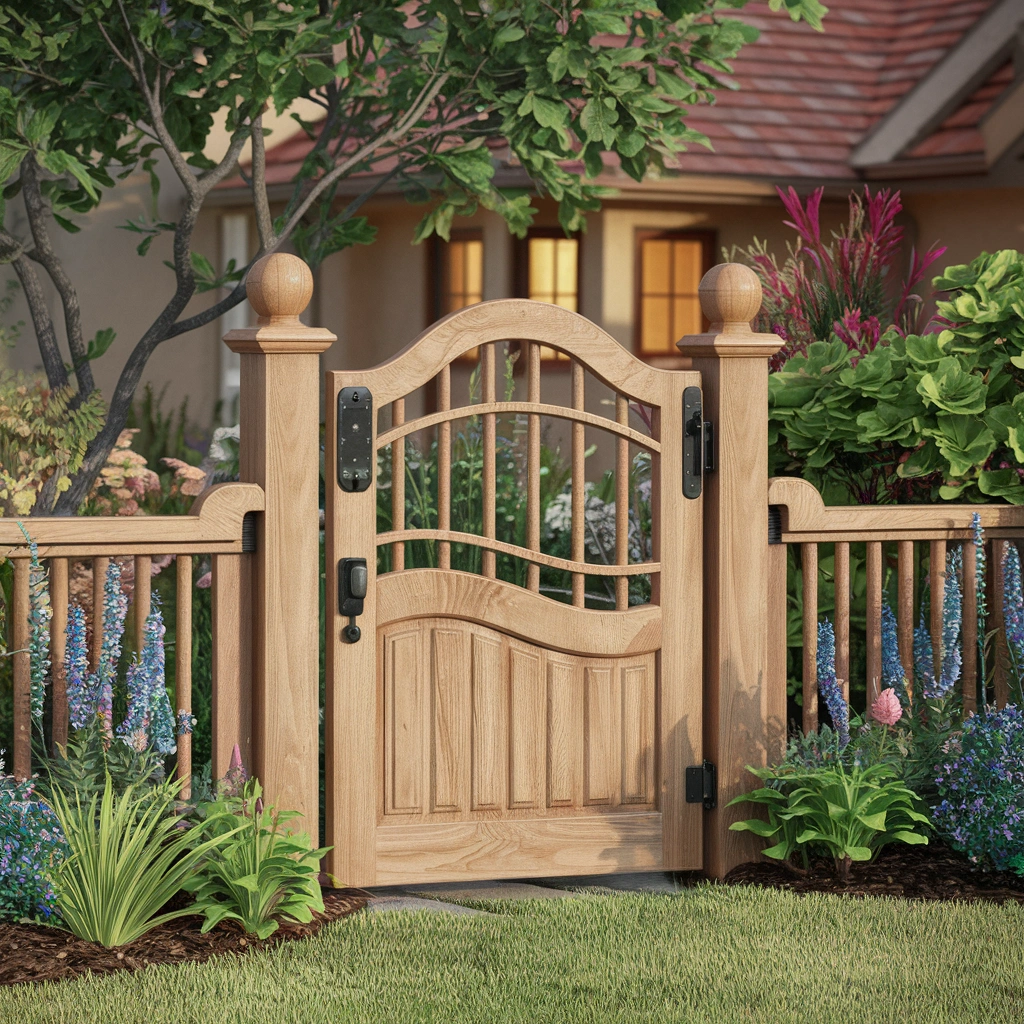
In this blog post, we’ll explore seven inspiring garden gate ideas that can add joy and style to your entryway. Along the way, we’ll discuss how to pick the right materials, delve into design inspirations, and guide you through the installation process. So, grab a cup of tea and settle in as we unlock the secrets to creating an inviting, joyful entryway that will have your neighbors saying, “Wow, I love your garden gate!”
Table of Contents
The Importance of a Garden Gate for Your Home
When you think about your home and garden, what’s the first thing that comes to mind? For many, it’s the inviting entrance that makes a statement. A beautiful garden gate can transform an ordinary entryway into something truly extraordinary. In this section, we’ll explore the importance of a garden gate and how it enhances your home’s curb appeal, security, and overall aesthetic.
Enhancing Curb Appeal
Let’s start with curb appeal. You might have a stunning garden filled with flowers and greenery, but without a captivating entrance created by a garden gate, those efforts might go unnoticed. A well-designed garden gate serves as a focal point, drawing the eye and making your garden feel welcoming.
- First Impressions Matter: Just like meeting someone for the first time, the entryway sets the tone for what’s inside. A garden gate that aligns with your home’s style—be it rustic, modern, or traditional—can enhance that first impression.
- Visual Impact: Consider a vibrant, hand-painted wooden gate that invites guests into your garden oasis or a sleek metal gate that speaks to contemporary elegance. Each type of garden gate tells a different story.
Defining Spaces
Have you ever felt like your garden could use a little organization? A garden gate can help define spaces, creating a sense of flow throughout your outdoor areas.
- Separate Zones: Think about how you might want to divide your vegetable garden from the flower beds or a cozy seating area. A garden gate can seamlessly guide visitors from one space to another, enhancing the experience.
- Functional Aesthetics: A beautifully crafted gate not only serves a practical purpose but also adds to the visual narrative of your garden design.
Security and Privacy
In today’s world, ensuring security has become more crucial than ever. A sturdy garden gate can provide peace of mind while adding an attractive element to your home.
- Protect Your Space: With a robust garden gate, you can deter unwanted visitors and keep pets or children safe within your yard. Whether you opt for a tall wooden gate or a wrought iron option, the element of security is a top priority.
- Enhancing Privacy: If your garden is your sanctuary, a garden gate can provide privacy from the outside world. It lets you enjoy your outdoor space while maintaining a sense of privacy.
Complementing Your Landscape Design
Every detail matters in landscape design, and a garden gate plays a crucial role in tying everything together.
- Style Alignment: Your gate should reflect the overall style of your home and garden. A charming, weathered wooden gate suits a countryside cottage, while a sleek, metallic gate complements a modern dwelling. Choose a garden gate that resonates with you!
- Aesthetic Value: Beyond functionality, a garden gate can add significant aesthetic value. It acts as a transition between the outside world and your personal paradise, encouraging people to step inside and explore.
Practical Considerations
Finally, let’s not forget the practical aspects of choosing a garden gate.
- Durability and Maintenance: Opt for materials that withstand the elements. For example, treated wood may require occasional sealing, while vinyl and metal can offer lower maintenance.
- Functionality Matters: Ensure your garden gate swings open easily and closes securely. This might seem obvious, but it’s crucial for day-to-day use and safety.
Types of Garden Gates to Consider
When diving into garden gate ideas, it’s essential to recognize the different types of garden gates that can elevate your outdoor space. Choosing the right gate can enhance your garden’s aesthetic, functionality, and security. So, grab a cup of tea (or coffee, I won’t judge), and let’s explore various garden gate options that will undoubtedly spark your creativity!
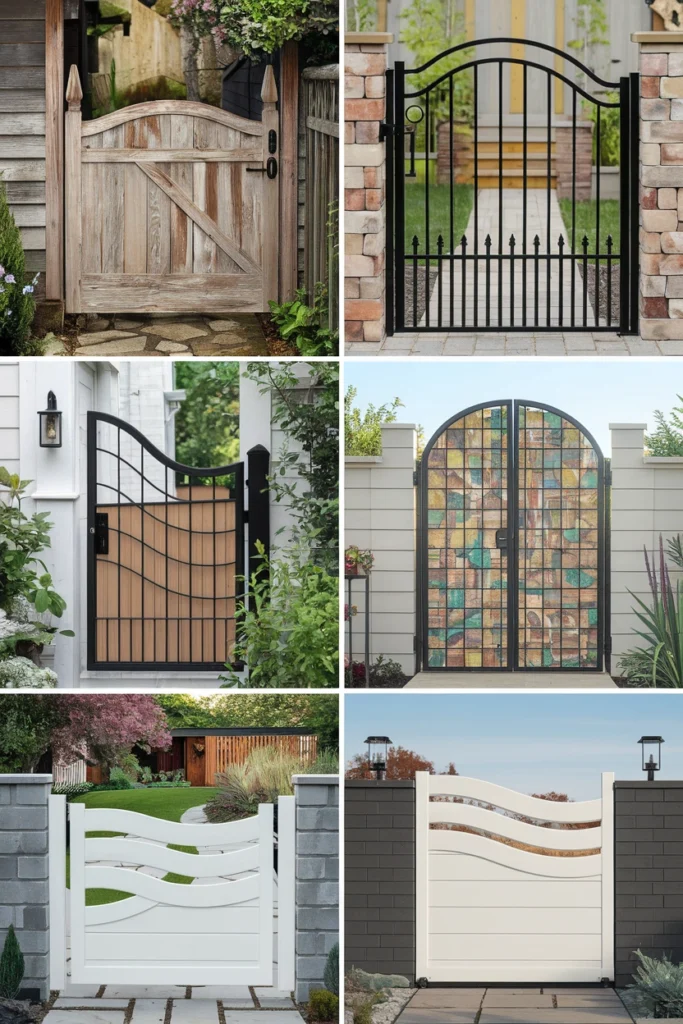
Wooden Garden Gates
Let’s kick things off with the classic choice: wooden garden gates. There’s something timeless about wood that effortlessly blends into most garden styles.
- Versatility in Design: Wooden gates come in various styles, from rustic picket gates to sleek modern designs. You can easily customize a wooden gate with paint or stains that match your home.
- Natural Aesthetic: The warmth of wood can make your garden feel inviting. Imagine a beautifully stained wooden gate adorned with climbing roses—such a picturesque scene!
- Types of Wood: Options include cedar, redwood, and treated pine. Cedar is especially popular because it naturally resists decay and insects.
Metal Garden Gates
Next up are metal garden gates, which offer durability and a modern touch. If you’re looking for something that can withstand the elements while still making a statement, metal is a fantastic option.
- Security and Strength: Metal gates provide a robust barrier, making them ideal for securing your property. Whether wrought iron or aluminum, they stand up to weather like champions.
- Stylish Designs: From ornate wrought iron to sleek aluminum, metal gates can be beautifully crafted to suit any style. Think of an intricate iron gate as a stunning work of art that greets your guests.
- Low Maintenance: Unlike wood, metal gates don’t require regular staining or painting. A simple wash with soap and water typically gets the job done!
Composite Gates
For those looking for an eco-friendly option, composite gates are an excellent choice. Made from recycled materials, these gates combine style and sustainability.
- Durability: Composite gates resist fading, rot, and warping, making them a low-maintenance option. You won’t have to worry about weathering!
- Custom Colors: Enjoy a wide array of colors and styles without the upkeep. Your gate can look brand new for years with minimal effort.
- Eco-Friendly Choice: By choosing composite materials, you are contributing to a more sustainable future. It’s a win-win for you and the environment!
Vinyl Garden Gates
Vinyl garden gates are gaining popularity, especially among homeowners who prioritize low maintenance. These gates offer a clean, contemporary look that can enhance your garden’s overall appeal.
- No Painting Required: Forget about peeling paint or fading colors! Vinyl gates retain their original color, and they’re easy to clean with just soap and water.
- Variety of Styles: From traditional to modern, vinyl gates come in many designs. You can find options that mimic the look of wood without the inherent drawbacks.
- Resistant to Elements: Vinyl is resistant to moisture, making it a great option in both sunny and rainy climates. It won’t rot or rust!
Decorative Garden Gates
Finally, let’s talk about decorative garden gates. These gates serve as a unique expression of your style and can transform your entryway into an enchanting visual experience.
- Artistic Flair: A decorative garden gate can be anything from a whimsical fairy tale design to an elegant, ornate piece. Consider gates with arches or intricate carvings to make a statement.
- Personal Touch: You can personalize a gate with colors, embellishments, or even your family name. It’s a great way to add character to your garden.
- Creating a Focal Point: A stunning decorative gate can act as a focal point in your garden, drawing visitors’ eyes and sparking conversation.
Garden Gate Design Inspirations
When it comes to garden gate ideas, creativity knows no bounds! In this section, we’ll explore various design inspirations that can elevate your outdoor space and create a joyful entryway. Whether you prefer rustic charm or modern elegance, you’ll find some design concepts that spark your imagination and resonate with your personal style.
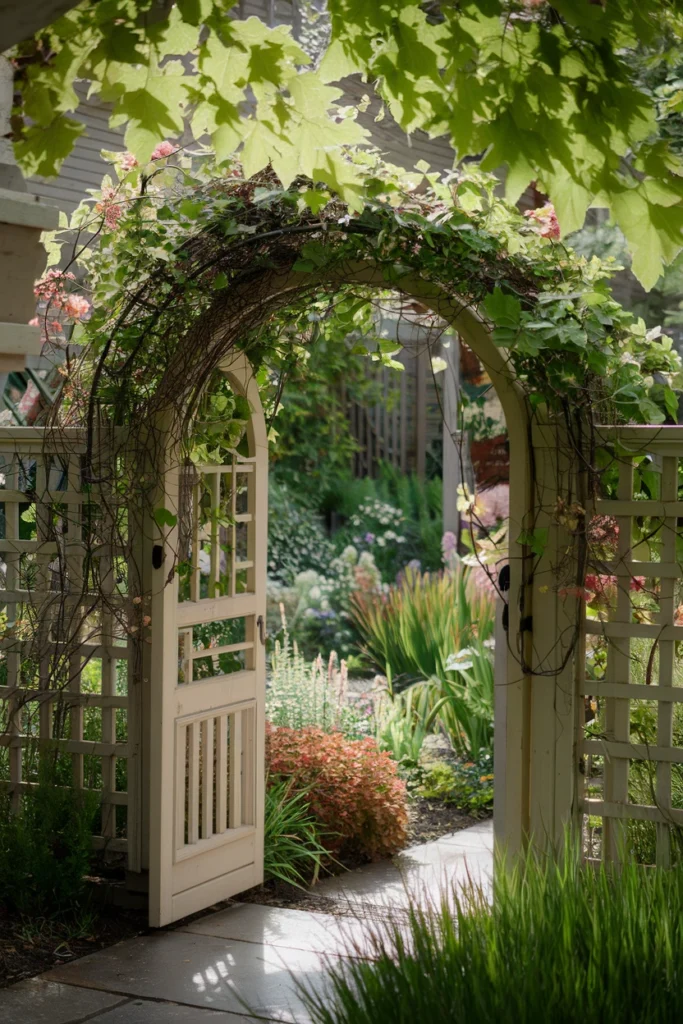
Rustic Designs
Let’s start with rustic designs. There’s something incredibly inviting about a wooden garden gate with a weathered finish.
- Natural Aesthetics: Imagine a beautifully crafted wooden gate made from reclaimed barn wood, complete with the character and charm of age. This type of gate not only serves a purpose but tells a story of its own.
- DIY Potential: If you’re a DIY enthusiast, consider building your own rustic gate. You could use old pallets or scrap wood for a custom project that showcases your handiwork.
- Accents of Nature: Adorn your rustic gate with climbing plants like ivy or honeysuckle for a dreamy, overgrown effect. It offers a fairytale charm that simply invites guests to explore your garden.
Modern Minimalist Gates
On the other end of the spectrum, modern minimalist gates provide a sleek and sophisticated look that appeals to contemporary tastes.
- Clean Lines: Think of a smooth, horizontal slat gate finished in matte black or a crisp white hue. The simplicity makes for a striking contrast against lush greenery.
- Materials Matter: Metal or composite materials can deliver that clean aesthetic while providing durability. A minimalist garden gate can serve as an elegant entry without being overly decorative.
- Function Meets Form: The beauty of a modern design lies in its functionality. Opt for a gate that opens easily and securely while still looking chic.
Arched Garden Gates
Arched garden gates hold a special place in garden design. They add a touch of whimsy and elegance that can enhance any entryway.
- Visual Interest: An arch draws the eye upward, creating a sense of grandeur and openness. Imagine stepping through a beautifully arched wooden gate, leading you into a tranquil garden oasis.
- Space for Decor: Arched gates are perfect for draping climbing plants. Consider adding flowering vines that cascade over the arch, creating a natural, picturesque frame for your entrance.
- Traditional Meets Modern: You can find arched gates that incorporate both traditional and modern elements, ensuring a lovely fit for any style of home.
Lattice and Trellis Gates
Lattice and trellis gates offer a unique twist to traditional designs and are perfect for those who love to incorporate greenery into their garden aesthetics.
- Perfect for Climbing Plants: These gates can double as trellises for climbing flowers or vines, adding both beauty and functionality. You can easily create a living wall on your gate!
- Light and Airy Feel: The open design of a lattice gate allows light and air to flow through, making your garden feel spacious and inviting.
- Customizable: You can paint or stain the lattice to match your garden’s color scheme, allowing you to maintain your personal aesthetic.
Custom and DIY Gates
Last but certainly not least, let’s talk about custom and DIY gates. Nothing says “I love my garden” like a gate that you’ve crafted yourself!
- Personal Touch: Building your own garden gate allows for complete personalization. Choose the materials, colors, and designs that speak to you.
- Unique Styles: You can create any style you want—be it whimsical, traditional, or a blend of both. Use repurposed materials for a charming, eco-friendly option.
- Cost-Effective Solutions: Going the DIY route can save you money while giving you a chance to show off your creativity. Plus, it’s a great way to spend a weekend!
Choosing the Right Materials for Your Garden Gate
When it comes to garden gate ideas, the materials you choose are just as important as the design itself. The right material not only contributes to the aesthetic appeal but also affects the durability and maintenance of your gate. In this section, we’ll break down the different materials available for garden gates and help you find the perfect match for your home and style.
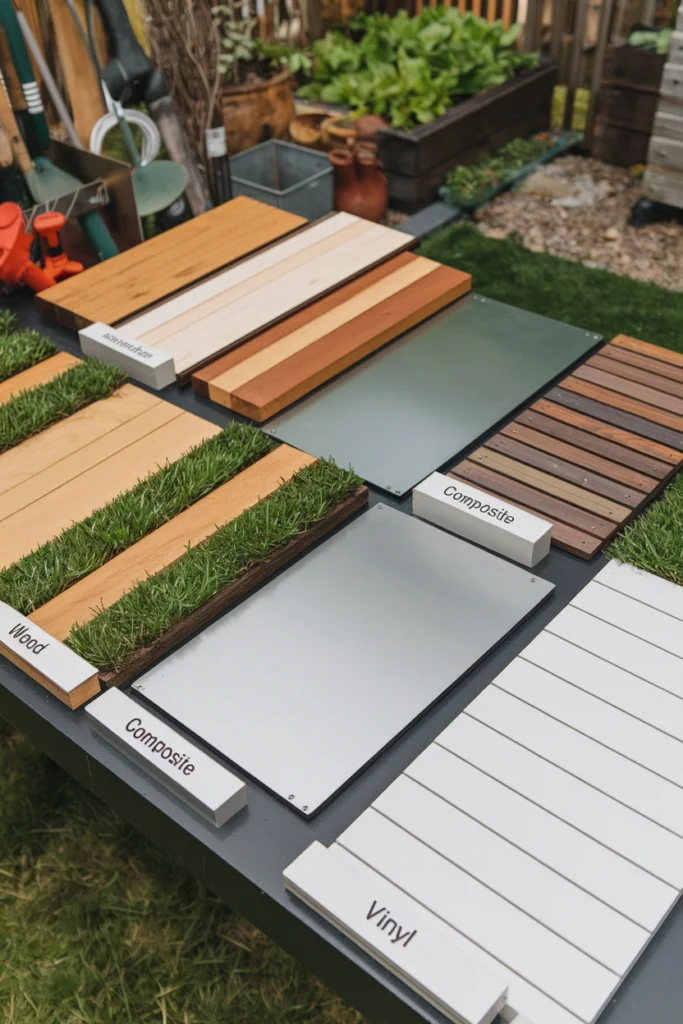
10 Amazing Garden Fencing Ideas: Easy and Budget-Friendly Projects
Understanding Material Options
Let’s start by looking at the most common materials used for garden gates. Each has its unique benefits and suitability, so understanding your options is key.
- Wood: A classic choice for garden gates, wood offers warmth and traditional charm. Properly treated wood can last for years, but it does require regular maintenance.
- Metal: Known for its durability, metal gates (like wrought iron or aluminum) provide excellent security and can be beautifully designed. They tend to require less maintenance than wood.
- Composite: Made from recycled materials, composite gates are eco-friendly and resistant to rot, providing a great balance of aesthetics and durability.
- Vinyl: This low-maintenance option is perfect for busy homeowners. Vinyl gates resist fading and don’t require painting, making them an attractive choice for many.
Weighing Durability vs. Aesthetics
When choosing garden gate materials, it’s essential to balance durability with aesthetics.
- How Long Will It Last?: Consider how much wear and tear your gate will face. If you live in a rainy area, for example, you might want to avoid untreated wood, which can warp or rot.
- Styling Your Space: Your gate should complement your home’s style. A sleek metal gate might fit perfectly with a modern home, while a rustic wooden gate suits a country cottage.
Maintenance Requirements
Let’s talk maintenance—an important factor when considering garden gate ideas.
- Wood: Requires regular staining or painting to protect it from the elements. You’ll want to check for signs of rot or damage, especially after harsh weather.
- Metal: Might need periodic rust treatment or painting if the finish chips. However, well-maintained metal gates can last a lifetime.
- Composite: Generally requires little maintenance, but occasional cleaning may be needed to prevent dirt buildup.
- Vinyl: A scrub with soap and water is all it usually takes to keep a vinyl gate looking great.
Environmental Considerations
If you’re eco-conscious (and who isn’t these days?), then consider the environmental impact of your material choice.
- Sustainable Wood Options: Look for FSC-certified wood that comes from responsibly managed forests. This way, you can enjoy the beauty of wood without harming the environment (FSC).
- Recycled Materials: Composite gates made from recycled materials provide a sustainable option that also looks good. It’s a clever way to incorporate eco-friendliness into your garden design.
Cost Analysis
Finally, let’s talk about cost because, let’s face it, we all have a budget.
- Wood: The costs can vary widely based on the type of wood you choose. Cedar and redwood tend to be more expensive but last longer.
- Metal: While the initial investment might be higher, metal gates can save you money in the long run due to their durability.
- Composite and Vinyl: These materials often fall in the mid to high price range, depending on the manufacturer. They may be more cost-effective over time due to low maintenance needs.
Installing Your Garden Gate: A Step-by-Step Guide
Now that you’ve explored various garden gate ideas and found the perfect design and material for your space, it’s time to tackle the installation. Installing a garden gate might seem daunting, but with a bit of preparation and the right tools, you can do it yourself. Let’s walk through this process step-by-step, ensuring your new garden gate looks stunning and functions perfectly.
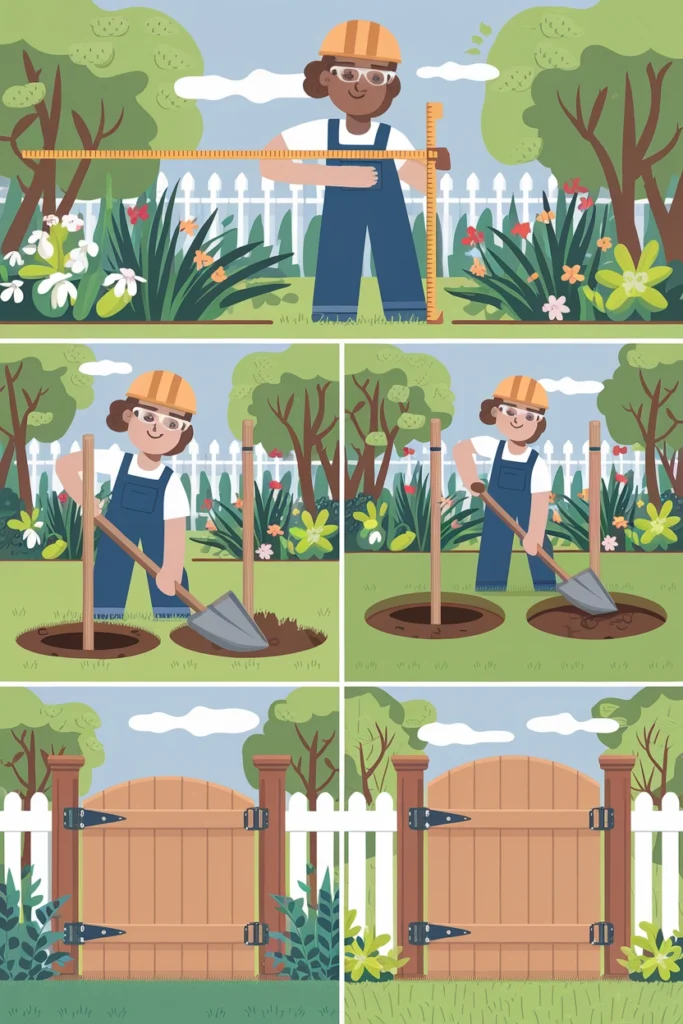
Preparing the Site
The first step in installing your garden gate is preparing the site. This is where the magic begins!
- Measure Your Space: Before anything else, measure the area where your gate will go. A standard garden gate is typically around 3 to 4 feet wide, but you want to ensure it fits your specific needs.
- Check for Level Ground: Make sure the ground where you’ll install the gate is level. If it’s uneven, you might need to do some digging or filling to create a flat surface.
- Plan for Post Placement: Decide where your gate posts will go. You’ll want them to be sturdy, as they will support the entire gate.
Tools and Materials Needed
Having the right tools at your fingertips makes everything easier! Here’s what you’ll need for your garden gate installation:
- Tools:
- Post hole digger
- Level
- Tape measure
- Hammer or power drill
- Screwdriver
- Shovel
- Concrete mix (for securing posts)
- Materials:
- Your chosen garden gate
- Gate posts (wood or metal, depending on your design)
- Hinges (make sure they’re strong enough for your gate)
- Latch mechanism (don’t forget this for security!)
Installation Process
Now that you have everything ready, let’s dive into the installation process for your garden gate.
- Dig Post Holes: Using your post hole digger, create holes for your gate posts. Each hole should be about two feet deep for stability, especially if you live in an area with high winds.
- Set the Posts: Place the gate posts in the holes and use a level to ensure they’re straight. Pour concrete around the posts to secure them in place, and let it set for at least 24 hours.
- Attach the Hinges: Once the concrete has cured, it’s time to attach the hinges. Position the gate on the posts and mark where the hinges will go. Typically, you’ll want to place two hinges on the gate, spaced evenly apart.
- Hang the Gate: With the hinges attached, lift the gate into place and secure it to the posts. Make sure it swings freely and aligns well with the ground.
- Install the Latch: Finally, attach the latch mechanism to your gate. This will ensure your gate closes securely and provides the safety and privacy you desire.
Common Mistakes to Avoid
As you install your garden gate, keep these common pitfalls in mind:
- Unlevel Posts: Make sure to double-check that your posts are level before pouring concrete. Unlevel posts can lead to a crooked gate.
- Skipping the Concrete: Securing your posts in concrete is crucial for stability. Don’t skip this step, especially if you want your gate to last!
- Neglecting Maintenance: Once your gate is installed, don’t forget about regular maintenance. Check the hinges and latch periodically to make sure everything functions smoothly.
How to Maintain Your Gate Post-Installation
Congratulations on your new garden gate! Now, let’s talk about maintenance to ensure it stays beautiful and functional for years to come.
- Regular Inspections: Check for any damage to the gate, hinges, and latch regularly. Tackle any issues promptly to avoid larger problems later on.
- Cleaning: Depending on the material of your garden gate, some light cleaning may be required. For wooden gates, look for signs of wear or rot, while metal gates may need rust treatment.
- Seasonal Care: In the colder months, inspect your gate for wear and tear from frost or moisture. You might want to apply a sealant to wooden gates to protect them during harsh weather.
Conclusion
And there you have it—a comprehensive guide to garden gate ideas that will inspire you to create the perfect entryway! As we’ve explored, choosing the right garden gate is more than just a matter of aesthetics; it’s about defining your space, enhancing security, and expressing your personal style.
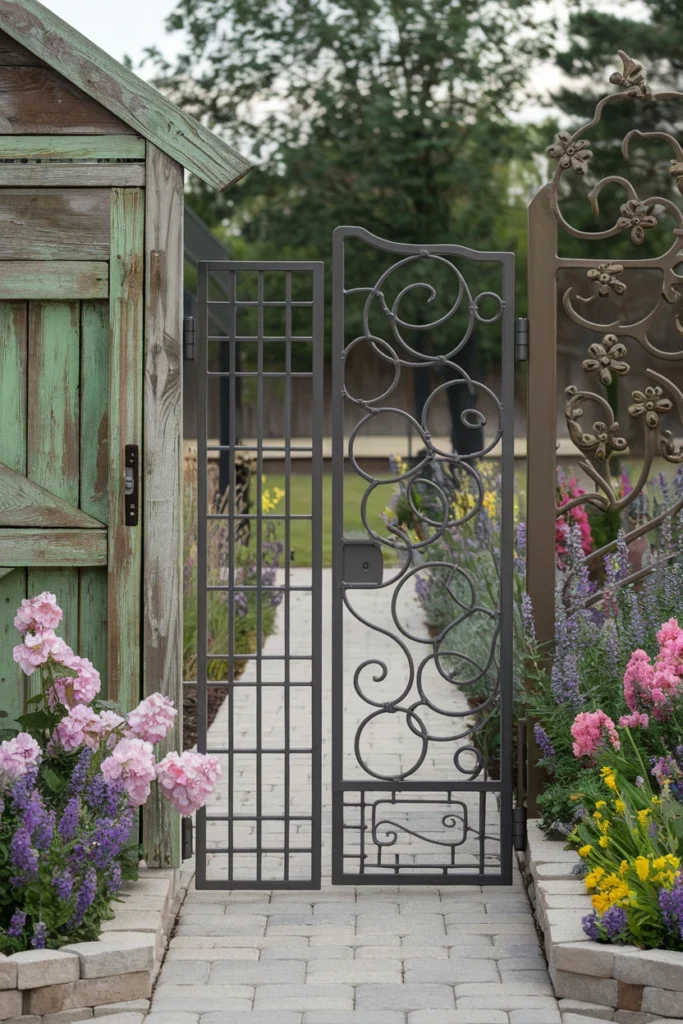
Have you thought about which design resonates with you the most? Whether you lean towards a charming rustic wooden gate, a stylish metal option, or even a DIY masterpiece, remember that your gate should reflect your tastes and the character of your home.
So, as you embark on this journey to elevate your outdoor space, keep those practical considerations in mind—like durability and maintenance—while letting your creativity flow. After all, a garden gate isn’t just an entryway; it’s the first glimpse into your little piece of paradise.
Let’s make that entrance as joyful and inviting as the garden it leads to. Happy gardening, and I hope you find the perfect gate that makes your heart smile every time you walk through it!
FAQ
1. What styles of garden gates are popular?
Common styles include rustic wooden gates, modern metal gates, arched designs, and decorative options. Each style brings a unique charm to your garden.
2. How do I choose the right material for my garden gate?
Consider factors like durability, maintenance, and aesthetics. Wooden gates offer warmth, metal gates provide security, and vinyl gates are low-maintenance.
3. Can I install a garden gate myself?
Absolutely! With the right tools and a bit of guidance, you can install a garden gate. Use a step-by-step guide to guarantee a seamless process.
4. How often should I maintain my garden gate?
Regular inspections are a good idea. Check hinges, latches, and the overall condition of the gate at least once a season to keep it in top shape.
5. What can I do to make my gate more secure?
Opt for strong materials, use a sturdy latch, and consider adding locks for additional security, especially if you have children or pets in the yard.
